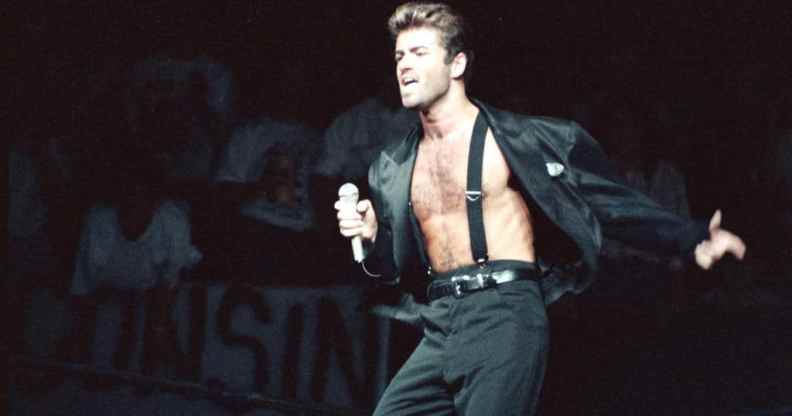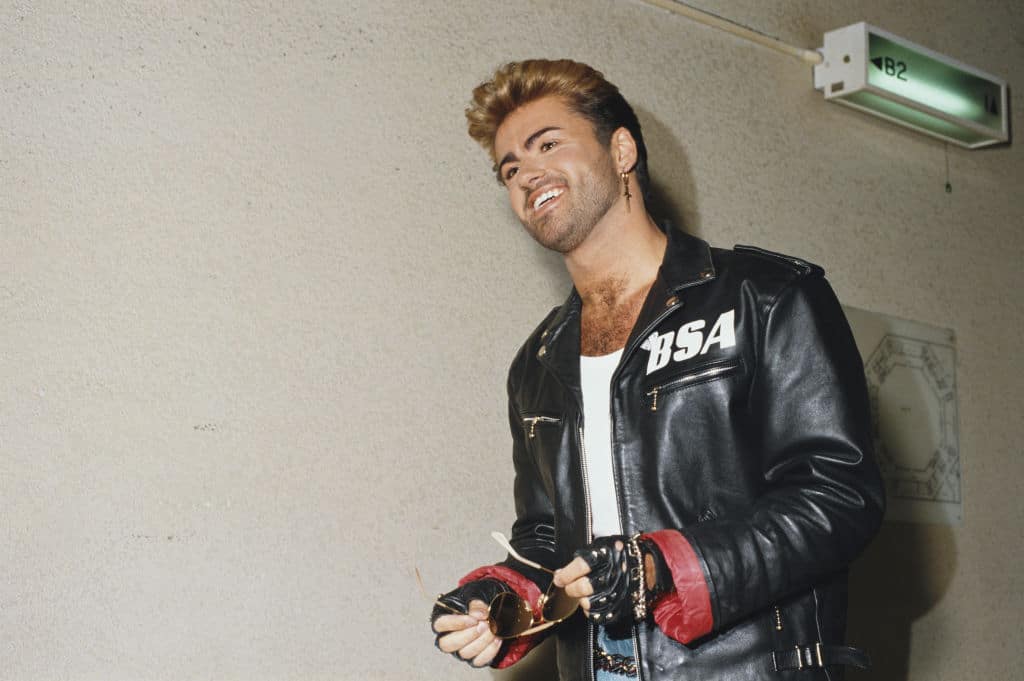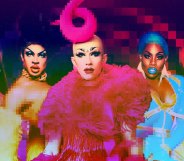How George Michael met the love of his life – and watched him die 18 months later

Photo of George Michael. (Jim Steinfeldt/Michael Ochs Archives/Getty)
James Gavin still remembers the moment he fell in love with George Michael.
“I’m a sucker for sad songs, and I’m a sucker for people in pain, artists in pain, who translate that into beautiful music, and that is the story of Older,” James says.
The album Older, released by George Michael in 1996, was inspired by Anselmo Feleppa, the love of his life. Tragically, Anselmo died from AIDS-related illnesses a year-and-a-half after they met.
“George had this very narrow six-month window of time in which he felt that he had found true love – something he thought would elude him forever,” James explains.
Losing the man he loved so deeply sent George into a downward trajectory. The relationship came to define his life, as James writes in his new biography, George Michael: A Life, a meticulously researched, fascinating deep-dive into a man whose music shattered hearts.

George Michael grew up in a ‘homophobic’ environment
George Michael was born in 1963 to Greek-Cypriot restaurateur Kyriacos Panayiotou and English dancer Lesley Angold. He grew up in London in what was a fiercely paternalistic and homophobic environment.
“All of our issues begin in childhood with our parents, don’t they?” James says.
“George had on the one hand this intimidating, tough, Greek-Cypriot immigrant father who had worked his way up from a dirt-road village to become a successful restaurateur in north London. He had the same masculine precepts that all men of his generation had, but a little bit more so.”
Kyriacos held deep convictions about how boys should express themselves, and he wasn’t afraid to enforce his views.
“His dad thought men were men and girls were girls,” James explains. “He believed the homophobia of the day and George grew up around this. Words like ‘poof’ were commonly used in the household.”
On the other hand, George’s mother loved him “unreservedly”, but she was terrified her son would have a “tragic” life if he was gay. Her own brother was a gay man who had died by suicide.

George was always close to his mother, but his relationship with his father was strained.
“Towards the end of his life, George said his father had softened and become a nicer guy, but the damage was done. Lesley, his mother, spent the rest of her life trying to make up to George for what had gone wrong in his childhood.”
He achieved stardom in a world that was deeply hostile to gay men
From the age of seven, he knew he wanted to be famous – he had a yearning to leave his imprint on the world, but as he reached his teenage years, he became terrified his sexuality would stop him from reaching for the stars.
“He felt on the one hand this tremendous drive to be famous, to make it to the top and to be loved by everyone,” James says. “But on the other hand, he had this spectre of fear hanging over him – what if people found out? Because then the entire dream would dissipate.”
In 1981, George formed Wham! with Andrew Ridgeley. They instantly achieved stratospheric success – their debut album Fantastic topped the UK charts. By 1986, George had gone solo.
It wasn’t an easy time to be openly gay. Homophobic attitudes were rife, and the emergence of HIV and AIDS led to a flurry of hatred. Gay men were mocked and denigrated in the media, with hateful headlines wishing death on queer people. In that context, George Michael kept his sexuality a closely guarded secret.

“Today it’s an asset if you are LGBTQ+,” James explains. “Back in George’s day, very few artists were out.
“Everybody knew about Boy George and at that point, everybody knew about Elton, but Elton and Boy George had this clown-like image and that was OK. However, if you were a handsome, sexual figure like George was, that made you threatening because suddenly you were a sexual creature. You were not a funny guy.”
As he became more and more famous, George became increasingly terrified his career would be ended if he came out as gay. While researching the biography at the British Library, James was reminded just how hostile the environment was for gay men at that time when he took a look at the tabloids of the day.
“There were reams of microfilm of The Sun and The News of the World and the Daily Mail, and starting in the mid ’80s, there were all these shocker covers that depicted AIDS as the ultimate horror show and gay people as complete pariahs, threats to society,” James explains. “George was aware of all this because you couldn’t not be – those newspapers were on every news stand. So the poor guy was really tortured about all of this.”
It was in that context that George met Anselmo. The year was 1991 and George was asked to perform at Rock in Rio in Brazil. What should have been a straightforward festival appearance ended up changing his life.
“At that point George was seriously despairing over whether he would find true love. Being a superstar obviously comes with problems, and being a closeted superstar was weighing on George enormously,” James says.

“While he was still in Rio he met this angel from on high. George was fond of telling this story about being on stage at the stadium and spotting Anselmo in the audience and making deep eye contact with him. My hunch from having interviewed people who were there that night is that that was probably George’s imagination, but it fits with how George felt about Anselmo – that he was this angel who had descended into his life.”
Anselmo chased George down and plotted to meet him, and the pair quickly fell in love. They had an idyllic six months together before Anselmo was diagnosed with HIV.
“In order to tell that story I had to turn back the clock and remember how it was back then,” James says. “The shadow of AIDS was hanging over everything and it had added this whole level of stigma and shame to gay life on top of all the other stigma and shame. George was in quite a predicament, and then he saw very quickly that this man who was a once-in-a-lifetime find was going to be taken away from him.”
Devastatingly, George didn’t feel he could be public about his relationship. He wasn’t by Anselmo’s side when he died, and he was unable to mourn the loss publicly.
Three defining tragedies set George Michael on a path to self-destruction
Anselmo’s death left a chasm in George Michael’s life, but it was only the first of three defining tragedies that would set him on a path towards self-destruction. In 1994, a judge tossed out his high-profile lawsuit against his record label, who he had accused of “professional slavery”. Three years later, his mother Lesley died.
“These three things together absolutely sent him reeling,” James says.

Reality became “too painful” for George to face. In the mid ’90s, he started to become reliant on drugs, and around 2003, he started using GHB.
“I think GHB is the biggest factor that led to George’s premature destruction. Then after that he got into crack cocaine. He just couldn’t face the world unstoned. And then of course, the deeper you get into those drugs, the more reliant your body becomes on them.”
George was “going seriously off the tracks”, James says. After Older, he struggled to find the mainstream success he had enjoyed in the ’80s and early ’90s. An album of standards failed to make an impact. Next up was Patience, an album that took five years to complete.
“That process was fraught with problems and distractions and public humiliations,” James says. “That album made number one in the UK but it flopped in the US. The sadness was that his career was mostly over in the United States.”
It didn’t seem George was seen as eternally cool, but rather as this disgraced ’80s popstar
Because George Michael’s star status had faded in the United States, it wasn’t easy for James to get a publisher to get behind a biography. Most weren’t interested, even after George’s death, feeling “nobody would care” about the singer’s life. He got a few offers to write a book quickly after George died on Christmas Day 2016 as a “cash-in”, but he knew it was time for a deeper look at the singer’s life.
“Around the time George died some other big people died – David Bowie, Lou Reed, Prince and Leonard Cohen, and all of them are seen as eternally cool. It didn’t seem that George was seen as eternally cool, but rather as this disgraced ’80s popstar whose relevancy had long-since faded,” James says.

Writing the biography helped James see just how much people still love George Michael – including a younger generation of LGBTQ+ people who weren’t around when the singer’s career took off.
George wasn’t always totally popular within the LGBTQ+ community, James explains. The way he was outed at the height of his fame led some to seeing him as an unsavoury figure unworthy of respect. That view has washed away with time.
“The fact that George was an extremely charismatic, gifted, handsome, commanding gay man standing on arena stages has made him seem like a real gay hero,” James explains.
“Younger gay men don’t know all of the backstory. They simply know that he was an inspiring, charismatic gay man standing up in front of the world doing his thing – and that’s enough.”
George Michael: A Life is published by Abrams.
How did this story make you feel?

